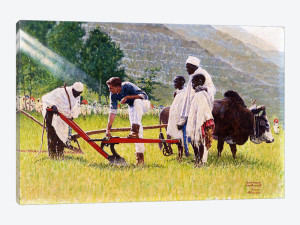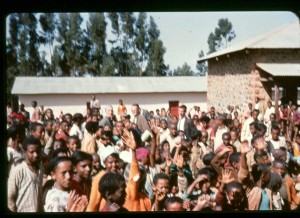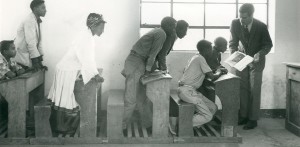Norman Rockwell and the Peace Corps, Part Two
While in Ethiopia Rockwell traveled to other Peace Corps site. In doing so, in Dessie, he found the subject for a famous paintings that appeared in Look Magazine.

This prominent Norman Rockwell painting is entitled, Peace Corps Ethiopia.
It shows Marc Clausen (Ethiopia 1962-64) working in a field with farmers
Marc Clausen was an agriculture/teacher Volunteer. He had graduated from the University of Arizona as an Aggie major and went to Ethiopia to teach agriculture. He was, in my recollection of those years, the only Ethie I PCV involved with agriculture. In Dessie, he told me recently, he had a demonstration field of approximately one hector a few miles from town and he took his students there for their classwork. Rockwell arrived by plane near the town of Kombolcha where there was a grassy landing field. Kombolcha was in the valley below this mountainous provincial town, Dessie, capital of Wollo. Dessie then had a population of less than 100,000. There were 19 PCVs stationed in Dessie. It was one of the larger encampments of Volunteers.
Rockwell had come to Dessie because of Marc. He wanted images of PCVs who were working in all sectors of the Peace Corps. That decision would lead him to travel later, in 1966, to India and Colombia to capture other PCVs at work overseas. Marc Clausen was the perfect Volunteer to profile in an illustration for Look Magazine. A young, good looking guy, he looked like a midwest farmer–(I can say that because I grew up on a midwest farm).
This painting was, as all of Rockwell’s painting were, staged and photographed.
Molly, Rockwell’s second wife, used a camera to photograph scenes Rockwell could paint later in his studio back home. In his studio, for example, he would add to the illustration the terraced mountains in the background which didn’t exist in up-country Ethiopia.
Asked by someone while in-country why he wasn’t showing the real conditions of the country, Rockwell remarked that Americans couldn’t handle the Third World. Instead, he said, he’d just apply a bandage to a child when he wanted to illustrate pain and suffering.
After meeting for lunch in a house Marc shared with three other PCVs, it was decided to stage the portrait at Marc’s demonstration farm, but Rockwell had just one request of Marc. He wanted him to change his shirt. And so Marc did. “He and I went into my bedroom and Rockwell picked the color he wanted me to wear and we rode the jeep out to the farm field.”
Marc had recently gotten from USIA a metal “duck foot plow,” as Marc explained. He was going to demonstrate it to the local farmers and his students as it was a much more useful and effective plow than what local farmers used. According to Jack Prebis (Ethiopia 1962-64) who later was an APCD in Ethiopia, “These plows were donated to Ethiopia courtesy of the old Marshall Plan following WWII. In the summer of 1963, we found them in the Ministry of Education’s warehouse, collecting rust. They were never distributed to farmers because they were too heavy and unwieldy for oxen to pull.”
Marc would agree about the plows not helping Ethiopians. Their mules should couldn’t pull the weight. Nevertheless, the plow was used in the illustration, as were several Ethiopian “models” who had gathered to watch the American. One of the models, Marc recalls, was his own compound zabagna,a night watchman.
Here are a few more photos from the Rockwells visit, forwarded to me through the kindness of John Schafer. You will note how well dressed the Peace Corps teachers were in the cities and in the provinces of the old Abyssinian Empire. It wasn’t for nothing that in Amharic we were known as Selam Guad, Messengers of Peace.

Rockwell in a sea of Nigus Tekle Haimanot Secondary School students;
PCVs Barry Hillenbrand and David Scribner are to his left

Rockwell at Nigus Tekle Haimanot School with PCVs David Scribner (glasses) and John Schafer

(left to right) PCVs Barry Hillenbrand, Molly Rockwell,
Marge Taylor (back to camera),
David Scribner , Carolyn Collins (back to camera) John Collins (1962-65)

Rockwell doing a sketch of a student and then gave it to the boy. Was he wise enough to keep it?

Rockwell made pencil sketches of this photo but never finished it.
John Schafer said he was given this rough sketches by Norman,
(which he was wise enough to keep).
A few more facts about Norman Rockwell’s Peace Corps paintings. He did four of them, the famous one John described in his first posting of Volunteers with JFK, entitled “The Peace Corps- JFK’s Bold Legacy,” and three others, one each for Africa, Asia and Latin America, entitled “The Peace Corps in Africa- A Volunteer in Ethiopia;” “The Peace Corps in Asia- A Volunteer in India;” and “The Peace Corps in Latin America-A Volunteer in Colombia.”
The Volunteer in the Colombian painting is Thomas LaBelle. The one in Rockwell’s painting of India is Tomi-Tara Diller.
Sometime in the late 1980s, Friends of Colombia and Friends of Somalia obtained permission from The Rockwell Foundation to print the four Peace Corps paintings and to sell them to raise money for projects in those two countries. One of my clients, the Graphic Communications International Union, AFL-CIO, CLC, agreed to help. Members of the GCIU donated their time and skill and a printing company provided press time. We ran off 250 of each of the four Rockwell paintings. I cannot recall the amount of money raised from sales or the specific projects we supported, I do know at the time we though the effort was quite successful.
Subsequently, Bob Colombo of Friends of Colombia and I presented a framed copy of “The Peace Corps-JFK’s Bold Legacy” to Sargent Shriver and “The Peace Corps in Africa- A Volunteer in Ethiopia” to Harris Wofford.
We attempted to obtain publicity about our efforts and presentations from the Peace Corps but nothing ever came of it.
An interesting note, Tomi Tara King Diller (my mother), the volunteer in the Peace Corps in India painting, never served in India. She served with her husband, Edmond Jess Diller, in Colombia.